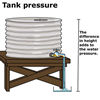Unlike gases, liquids such as water cannot be compressed, at least not noticeably so under everyday conditions. Water under pressure is really useful for cleaning down walls or the car; rain washes soil and rocks down rivers and streams; the ocean pounds against the shoreline creating cliffs and caves, and the whole Earth is shaped by the forces exerted by water.

|
Erosion by sea |
 Pressure from the household water supply arises because of gravitational
forces. Dams and water storage tanks are higher than the house so that
the stored water has gravitational potential energy. Sometimes pumps are
used to increase pressure where the gravitational potential energy of
the water is not enough to create the pressure required by the user.
Pressure from the household water supply arises because of gravitational
forces. Dams and water storage tanks are higher than the house so that
the stored water has gravitational potential energy. Sometimes pumps are
used to increase pressure where the gravitational potential energy of
the water is not enough to create the pressure required by the user.
 Water in action
Water in action
Surfers make use of the energy of water as they get raised by the surf
wave, then are pushed along the wave front.
Rising and falling of waves can also be used to turn generators that produce electric power.
 Beaches are formed by the force of water driving small pebbles and
sand towards the beach, then dumping it as the kinetic energy of the water
diminishes.
Beaches are formed by the force of water driving small pebbles and
sand towards the beach, then dumping it as the kinetic energy of the water
diminishes.
Water to electricity
 Gravitational potential energy stored in the water in dams when released
through pipes and allowed to run down hill is converted to kinetic energy
in the form of moving water. When this water hits the turbine blades in
a hydroelectric power station, the kinetic energy of the fast moving water
is converted through the turbine blades and generator into electrical
energy. In this way the pressure on the water in the dam is converted
to usable electrical energy at the bottom of the hill.
Gravitational potential energy stored in the water in dams when released
through pipes and allowed to run down hill is converted to kinetic energy
in the form of moving water. When this water hits the turbine blades in
a hydroelectric power station, the kinetic energy of the fast moving water
is converted through the turbine blades and generator into electrical
energy. In this way the pressure on the water in the dam is converted
to usable electrical energy at the bottom of the hill.
A river often starts high up in a mountain or raised terrain with lots of gravitational potential energy. It flows rapidly to begin with quickly converting its potential energy to kinetic energy, carrying with it rocks and debris of all sizes. As the river slows and the kinetic energy of the river decreases it can no longer move the larger rocks so they get left behind. As the river reaches the flat lower level plains, smaller and smaller particles are only able to be moved until, finally, near the estuary only the finest sand and silt is left. In this way the energy of water changes the characteristics of the river, eroding the upper reaches, transporting material and depositing material in the lower reaches.

|
Transportation by water |
| Copyright owned by the State of Victoria (Department of Education and Early Childhood Development). Used with Permission. |